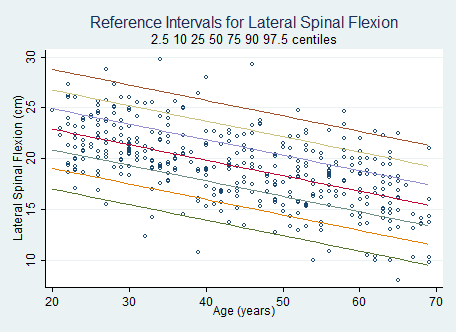Session Information
Session Type: Abstract Submissions (ACR)
Background/Purpose: Spinal mobility is frequently assessed in the follow-up of patients with axial SpA, which is also in accordance with the recommendations by the Assessment of Spondyloarthritis international Society (ASAS). However, the interpretation of spinal mobility measures has been hampered by the absence of reference values. We aimed to establish reference intervals (RIs) for spinal mobility measures.
Methods: A cross-sectional study (“MOBILITY-study”) was conducted among healthy volunteers aged 20-69 years old. Recruitment was stratified by gender, age (10-year categories) and height (10cm categories). Participants were Caucasian volunteering to be measured in the Netherlands and Portugal. Exclusion criteria were factors potentially influencing spinal mobility (eg. back surgery, low back pain). Several spinal mobility measures were assessed: tragus-to-wall distance (cm), occiput-to-wall distance (cm), lateral spinal flexion (LSF, cm), cervical rotation (degrees), intermalleolar distance (cm), chest expansion (cm), 10cm- and 15cm-Schober’s test. The Bath Ankylosing Spondylitis Mobility Index (BASMI) was computed. Using a generalized least squares approach, age-specific equations for percentiles of spinal mobility measures were derived. Each parameter of normal, exponential-normal or modulus-exponential-normal density was modeled as a fractional polynomial function of age. The estimated 95% RI (2.5th and 97.5th percentiles), as well as the 50th percentile, are presented. RIs can be computed for any age, but examples were chosen for the ages of 25, 35 and 45, ages in which these assessments have particular clinical relevance for comparison purposes with mobility measurements of patients with axial SpA.
Results: 393 volunteers were included (only the category of 60-69 year-old women with height >1.80m was incomplete, due to difficulties in recruitment). RIs were derived and are presented in the Table. Percentiles graphs were also plotted for each of the measurements, with the best-fitting equation. An example is given in the Figure for LSF. The lower border of the RI for both Schober’s 10cm and 15cm test lies below the “cutoff” of 5cm frequently used in clinical practice (see table). No individual had a BASMI<0.15, being the median value of 1.3 for a patient of 25 years old and increasing with age.
Conclusion: Age-specific RIs and percentiles were derived for each of the spinal mobility measures for normal individuals. These RIs may guide clinicians when assessing the mobility of patients with axial SpA, and may serve as cut-off levels for ‘normal’ vs. ‘abnormal’.
|
Table – Reference intervals (2.5th-97.5th percentiles) of spinal mobility measurements |
||||
|
|
|
Percentiles |
||
|
Spinal mobility measure |
Age |
2.5th |
50th |
97.5th |
|
Lateral spinal flexion (cm) |
25 |
16.2 |
22.1 |
28.0 |
|
35 |
14.7 |
20.6 |
26.5 |
|
|
45 |
13.2 |
19.1 |
25.0 |
|
|
Cervical rotation (degrees) |
25 |
62.0 |
80.7 |
99.3 |
|
35 |
58.6 |
77.2 |
95.8 |
|
|
45 |
55.1 |
73.7 |
92.3 |
|
|
Intermalleolar distance (cm) |
25 |
93.5 |
118.8 |
144.1 |
|
35 |
91.5 |
116.8 |
142.0 |
|
|
45 |
87.9 |
113.2 |
138.4 |
|
|
10cm-Schober’s test (cm) |
25 |
3.5 |
5.2 |
7.4 |
|
35 |
3.3 |
5.1 |
7.2 |
|
|
45 |
3.2 |
5.0 |
7.1 |
|
|
15cm-Schober’s test (cm) |
25 |
4.5 |
6.7 |
8.9 |
|
35 |
4.2 |
6.5 |
8.7 |
|
|
45 |
4.0 |
6.3 |
8.5 |
|
|
Chest expansion (cm) |
25 |
3.2 |
7.4 |
11.7 |
|
35 |
2.9 |
7.1 |
11.4 |
|
|
45 |
2.6 |
6.8 |
11.1 |
|
|
BASMI (0-10) |
25 |
0.66 |
1.30 |
2.27 |
|
35 |
0.65 |
1.42 |
2.60 |
|
|
45 |
0.73 |
1.64 |
3.03 |
|
Disclosure:
S. Ramiro,
None;
C. Stolwijk,
None;
A. M. Van Tubergen,
None;
P. Royston,
None;
D. van der Heijde,
None;
R. Landewé,
None.
« Back to 2012 ACR/ARHP Annual Meeting
ACR Meeting Abstracts - https://acrabstracts.org/abstract/reference-intervals-of-spinal-mobility-measures-in-normal-individuals-the-mobility-study/

